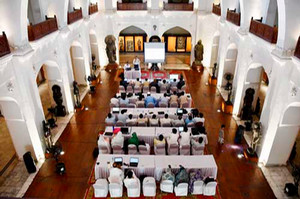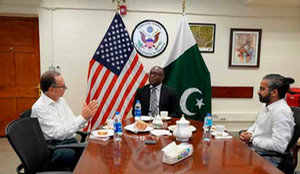
The heat was on -- 115-degree temperatures, 60-percent humidity -- and the cultural conservation training continued at Pakistan’s Peshawar Museum. Gabriele Guidi, professor of Informatics, and postdoc Umair Shafqat Malik had come too far, had too much important work to do (demonstrating the power of the Luddy School of Informatics, Computing, and Engineering-honed 3D and laser-scan technology for artifact conservation and restoration as part of a $250,000 grant), for unpleasant conditions to sideline them.
“Fans were running like an airport runway while we were presenting,” said Guidi, the director of Luddy’s Virtual World Heritage Lab.
The five-day July training for 35 KP Directorate of Archeology and Museums employees at the Peshawar Museum and Gor Khatri archaeological sites focused on artifact conservation, laser scanning, record keeping and 2D/3D digitization to preserve clay stucco and terracotta, coins and metal objects, decorated surfaces and architectural decorations. The technology allows restoration to begin before touching the artifact.
Demonstrations included going to an archaeological site for laser scanning.
Guidi said the employees, consisting of men and women, some with Ph.Ds., were impressed.
“They were very smart and very interested. They started slightly skeptical, then became enthusiastic when we did demonstrations to show what the technology can do.”
Training included theoretical exams, group projects, individual tests and final presentations.

Peshawar was once a powerful ancient center of learning that included the long-since destroyed giant Kanisha stupa, a mound-like structure used to store relics and promote meditation. Built around 2,000 years ago, it was one of the ancient world’s tallest buildings at nearly 400 feet.
Conquered by Alexander the Great around 326 BC, the area has a rich and diverse blend of Greek, Hindu and Buddhist art and archaeological ruins. The Gandhara art movement, a school of art depicting Buddhist myths and legends by mixing the Greek and Roman style with the Indian traditions, began there in the first century BC.
“Peshawar is a blending of Indian arts with the Greek arts,” Guidi said. “It’s Buddhist art in an Islamic country. The training was about protecting this art. There’s huge tourist potential.”
Through the Virtual World Heritage Lab, Luddy is on the cutting edge of using 3D and laser scan technology to analyze and restore ancient artifacts. Guidi and Malik showed researchers how to use 3D models rather than photographs to document artifacts as a first step in restoration.
“It’s much richer in information,” Guidi said. “The 3D is a digital twin of reality. That’s a great advantage.”
Over the years, Guidi has done multiple international restoration projects. He worked in Italy for the United Nations Educational, Scientific and Cultural Organization and the Italian Ministry of Foreign Affairs, as well as in Vietnam and Miramar.
While the 3D technology can be expensive (using a laser scanner can cost $40,000), Guidi also introduced low-cost, smart-phone-based approaches to ensure its use and popularity.
This was the first of four planned training sessions. Malik will return to Peshawar in September. Guidi is set to be back in December of 2025 to close the project, which is funded by the U.S. Department of State through the U.S. Consulate General Peshawar under the IU-SD Initiative for Safeguarding Cultural Heritage in Khyber Pakhtunkhwa.

The initiative helps bring in experts from the United States to train museum staff with the goal of displaying more objects in Pakistan provincial museums to help boost heritage tourism.
It fits in with the Virtual World Heritage Lab’s mission to apply the latest technologies to preserve and record important cultural heritage around the world.
Because the Peshawar site was close to the Afghanistan border, security was tight.
The week concluded with a celebration dinner led by museum, government and consulate officials.

